Videographers know that one can never have enough storage space. From organizing clips to recording footage for immediate use, you’ll want to have several cards at the ready that can keep up with your production. And if you’re into high-resolution 4K and 8K footage, you’ll need both higher storage and the fastest read and write speeds you can get.
What are SD Cards & how to choose them?
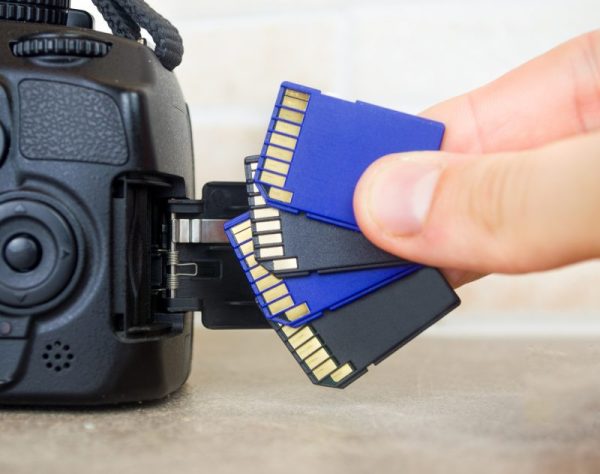
Photo by Depositphotos
- SD cards are a popular storage medium for video cameras because they are small, portable, and have a large capacity. They also are widely compatible with different types of cameras & devices.
- When choosing an SD card for your video camera, it’s important to consider the card’s speed and capacity. Video files can be quite large, so you will want a card with high capacity to store all your footage. You will also want to choose a card with a fast read/write speed to ensure smooth video recording and playback.
- SD cards come in different classes, which indicate their speed and performance. Class 10 cards are the most common and can handle-definition video recording, while UHS speed class 3 (U3) and video speed class 30 (V30) cards are designed for recording 4k and ultra-high definition video
- It’s also important to choose a reliable brand to purchase your SD cards from reputable sources. Counterfeit SD cards are common and can cause data loss or camera malfunctions.
- To protect your footage, always back up your SD card’s contents onto a separate storage device. You can do this by transferring the files to a computer or external hard drive, or by using cloud storage services
Overall, SD cards are a convenient and reliable storage option for video cameras, but it’s important to choose the right card and take proper precautions to ensure the safety of your footage.
Videographers know that one can never have enough storage space. From organizing clips to recording footage for immediate use, you’ll want to have several cards at the ready that can keep up with your production. And if you’re into high-resolution 4K and 8K footage, you’ll need both higher storage and the fastest read and write speeds you can get.
The Five Best SD Cards for Video Recording
- Sony SF-G Tough Series UHS-II SDXC Memory Card
- Samsung EVO Select MicroSD Memory Card
- SanDisk Extreme PRO SDXC UHS-I Card
- Lexar Professional 2000x SDXC UHS-II Card
- Transcend SDXC UHS-II U3
Let’s talk about each card in detail.
Sony SF-G Tough Series UHS-II SDXC Memory Card

If you need SD cards that are not only fast but nearly impossible to destroy, the Sony SF-G Tough Series are the best SD cards for video recording. These cards are what you’ll want to use alongside an adventure camera like a GoPro Hero or when shooting landscapes.
Sony Tough cards use a plastic casing that’s nearly 18 times stronger than a typical SD card. They are almost impossible to break in hand or by crushing them. Sony rates these cards as IPX6 dust-proof and PIX8 waterproof, allowing them to survive for a few days when submerged in up to 5 meters of water!
It’s worth mentioning that these SD cards have both bursts and sustained read and write speeds. For a single large file, you can see up to 299 MB/sec when transferring to and from the card! But for a series of files, you’re looking at the slower, but still excellent, 90 MB/sec rate, which is plenty for any use.
Sony Tough Series Pros: 300 MB/sec read and 299 MB/sec write speeds (burst), IPX6 dust-proof and IPX8 waterproof ratings, rugged plastic shell
Price: Check on Amazon
Samsung EVO Select MicroSD Memory Card
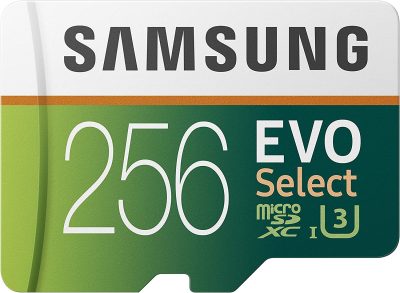
If your equipment uses a smaller Micro SD card slot (such as many smartphones) or you want the option of both, the Samsung EVO Select MicroSD Memory Card is a great option. Since it comes with a Micro SD to SD adapter, you can use the card on any device.
Despite their size, the Samsung EVO Select lines can hold up to 256 GB of data. The read speeds of this card are also excellent; at up to 100 MB/sec, you can transfer a 6GB file like a movie in just over a minute. And the write speeds of up to 90 MB/sec ensure the EVO select can keep up with the output of your 4K recording device without interruption!
Samsung EVO Select Pros: Micro SD card, includes standard SD card adapter, UHS Speed Class 3 (U3) rated, up to 265 GB of storage space
Price: Check On Amazon
SanDisk Extreme PRO SDXC UHS-I Card
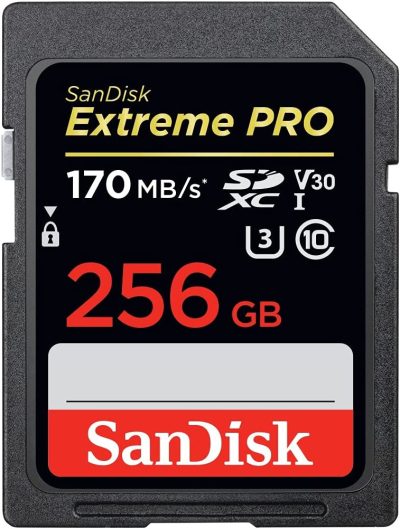
Popular and extremely affordable, the Sandisk Extreme PRO line is popular with videographers around the world. These are the SD cards you use when you want pure functionality. The read speed of 90 MB/sec is average but the write speed of 170 MB/sec is ideal for the demands that 4K video recording puts on an SD card.
What’s more, SanDisk manufactures these cards from 32GB all the way to 1 full terabyte, making this great for both 4K recording and storage! While it’s not as tough as the Sony series nor is it small enough for a cellphone like the Samsung EVO, the SanDisk Extreme PRO is ideal for the majority of DSLR and mirrorless videographers.
SanDisk Extreme PRO Pros: Comes in all sizes up to 1TB
Price: Check On Amazon
Lexar Professional 2000x SDXC UHS-II Card
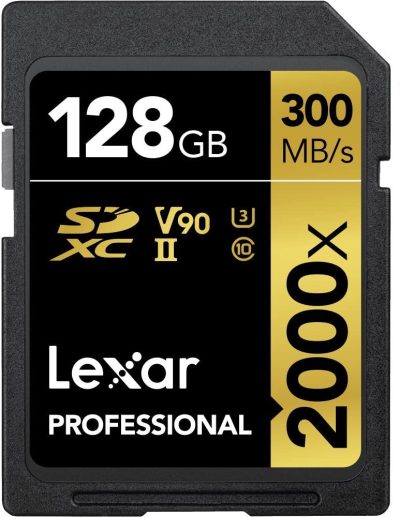
Sometimes speed is all that matters to us, especially if we’re recording 4K and 8K video. When it comes to high-quality cinematography where we simply want a reliable, high-capacity card, the Lexar Professional series has us covered.
Unlike some of the budget cards out there, these have sustained read and write speeds of over 250 MB/sec and burst read speeds of up to 300 MB/sec. These SD cards can write and transfer multiple gigabytes in mere seconds and do an even better job than the Sony Tough series.
While they aren’t as durable as those cards, SD cards in general are quite water and dust resistant so long as you take proper precautions. Sports, wildlife, and other action photographers who need to save huge numbers of RAW images in a single burst will also get a lot of mileage out of the Lexar Professional cards!
The only real issue with these cards is that they only come up to 128GB in size. Despite videographers often needing much more storage Lexar doesn’t make these ultrafast cards in 256GB or larger sizes.
Lexar Professional 2000x Pros: Extremely fast sustained read and write speeds (260 MB/sec) and vast burst read speeds (300 MB/sec)
Price: Check On Amazon
Transcend SDXC UHS-II U3
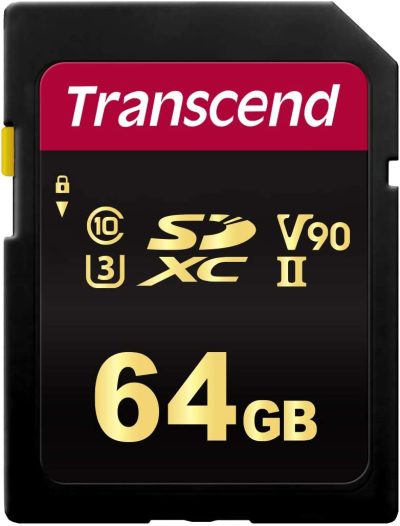
Last but certainly least are the Transcend SDXC UHS-II cards. The read and write speeds are ideal for any sort of large data file work; at 285 MB/sec read and 180 MB/sec write they can keep up with any DSLR or mirrorless video camera on the market.
And while they aren’t quite Sony Tough, the Transcend series is quite durable. They have IPX7 water resistance ratings, meaning they can be immersed in 1 meter of water for up to 30 minutes. They resist temperature extremes from -25°C to 85°C. They are also static and X-ray proof, which is valuable when going through an X-ray machine at the airport.
The only real fault I have with these cards is that they only come in 32 GB and 64GB sizes. For someone not interested in 4K this is plenty but if you want higher resolution video, you’ll want more storage space than this. But for the price, they are undoubtedly one of the best SD cards for video recording!
Transcend SDXC Pros: Extremely durable (heat, static, x-ray proof + water resistant), blazing fast read and write speeds
Price: Check On Amazon
Related posts
Best memory cards for digital cameras
Featured Photo by Depositphotos
Thanks for reading, I hope you enjoyed the article, in case you have any questions just drop them below & I will be happy to answer you.
If you enjoy the site, don’t forget to subscribe, we will only inform you when a new article is posted.









From my experience with a DSLR when choosing an SD card I would always go for the highest speed possible even if this meant choosing a bit lower capacity. But one thing that really frustrates me is the various speed symbols they use nowadays. Having Speed Class, UHS speed class and Video Speed class is not making things easy for those not very familiar with what all these symbols means. They do have to create a single universal coding that is easy to understand and stop using some of these old classifications. For example Speed class is almost not used anymore as all of them are class 10 anyway. Why still using such an old rating anymore?
Thank you for writing this informative article, I never knew what the different classes of SD cards were or really what to look for when buying one other than how many GB I needed, so this information will be helpful when I purchase my next SD card.
I didn’t know counterfeit SD cards were a thing! I usually purchase SanDisk or Sony because they are brands that I am familiar with.
Great article! very helpful and informative.
Glad that you find the article useful Jules!